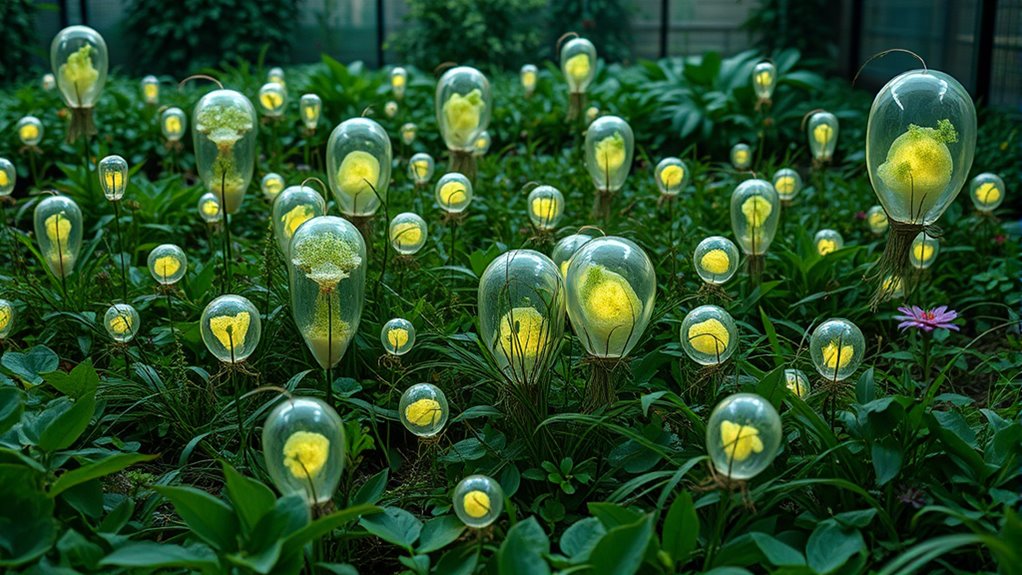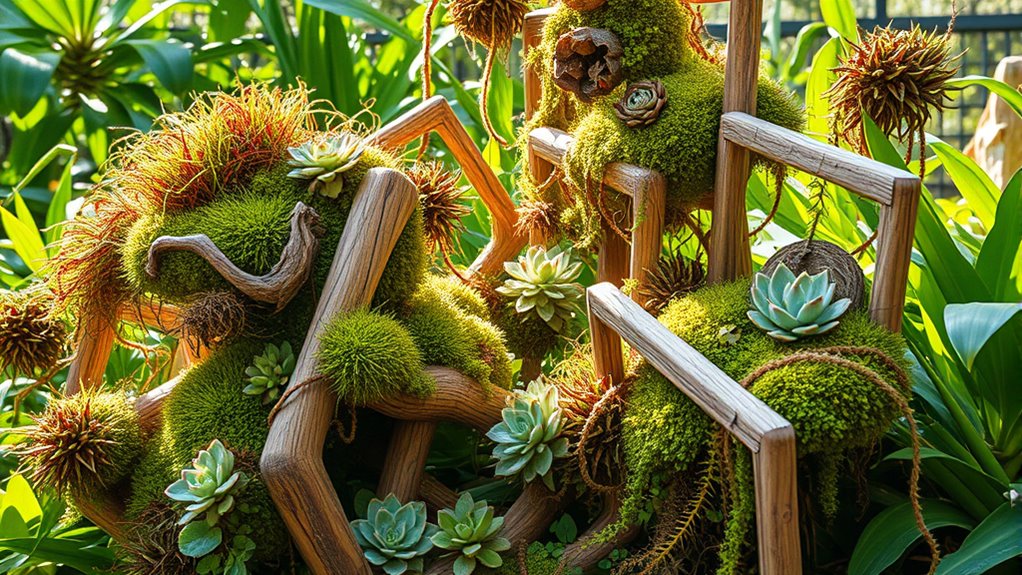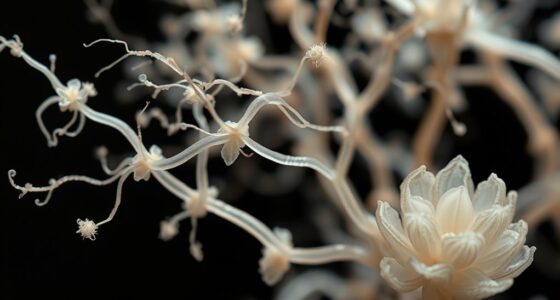When creating bioart, you should consider its environmental impact by evaluating the materials you use, like genetically modified organisms and lab supplies, ensuring they’re sustainable and biodegradable. Manage your energy, water, and waste efficiently, aiming for eco-friendly practices such as recycling and renewable energy. Upholding ethical standards helps protect ecosystems and living organisms, making your work more responsible. Exploring these strategies further will help you understand how to balance innovation with environmental care.
Key Takeaways
- Assess and minimize resource consumption, including energy, water, and materials used in bioart creation and maintenance.
- Use sustainable, biodegradable, and recycled materials to reduce ecological footprint and waste generation.
- Implement eco-friendly practices like composting, rainwater harvesting, and recycling to promote sustainability.
- Conduct lifecycle assessments to understand environmental impacts and guide responsible design choices.
- Collaborate with ecologists and adhere to ethical guidelines to ensure bioart projects do not harm ecosystems or living organisms.
Assessing the Environmental Footprint of Bioart Practices

Understanding the environmental impact of bioart practices is essential as the field continues to grow. By evaluating the footprint of your bioart projects, you can identify potential ecological risks and areas for improvement. This involves examining the materials you use, such as genetically modified organisms, growth media, and laboratory supplies, to determine their sustainability and disposal methods. You should also consider energy consumption during the creation and maintenance of living artworks. Tracking waste production and resource usage helps you understand how your practices affect the environment. Conducting a thorough impact assessment enables you to make informed decisions, minimize negative effects, and promote eco-friendly approaches within bioart. Incorporating sound design techniques can also enhance the sustainability of your projects by reducing unnecessary resource use. Ultimately, this proactive evaluation supports responsible innovation and the sustainable evolution of the field.
Resource Consumption and Sustainability in Living Artworks

Managing resource consumption is essential for ensuring the sustainability of living artworks. You need to carefully consider water, energy, and materials to minimize environmental impact. Efficient systems can reduce water use in hydroponic setups or plant cultivation, while renewable energy sources power maintenance without excess emissions. Selecting sustainable materials, like biodegradable or recycled supplies, helps lessen waste. Regularly monitoring resource use allows you to identify areas for improvement and avoid unnecessary waste. Incorporating eco-friendly practices, such as composting or rainwater harvesting, further enhances sustainability. Additionally, understanding the environmental impact of different materials and systems enables more informed decisions that support ecological health. By prioritizing resource efficiency, you not only support the longevity of the artwork but also demonstrate ecological responsibility, making your bioart a positive example of environmentally conscious creativity.
Ethical Dimensions and Ecological Responsibility in Bioart

As bioart pushes the boundaries of science and creativity, it also raises critical ethical questions about the responsibilities artists bear toward the environment and living organisms. You must consider how your work impacts ecosystems, ensuring it doesn’t cause harm or unintended suffering. Ethical bioart involves transparency about methods, respecting the boundaries of nature, and avoiding exploitation. You’re responsible for weighing the benefits of your creations against potential ecological risks. It’s essential to reflect on whether your art contributes positively or risks disrupting delicate biological balances. By prioritizing ecological responsibility, you demonstrate respect for living systems and acknowledge your role in promoting sustainable, mindful artistic practices. Ethical considerations are not just moral obligations—they safeguard the environment for future generations and uphold the integrity of bioart. Additionally, understanding the importance of empathy and active listening can help artists better gauge the potential ecological impact of their work and foster a more conscientious approach to bioart.
Strategies for Minimizing Ecological Impact in Bioart Creation

To minimize ecological impact in bioart creation, you need to adopt deliberate strategies that prioritize environmental safety and sustainability. First, choose eco-friendly materials like biodegradable substrates and non-toxic pigments. Second, optimize resource use by recycling water and energy during the process. Third, consider the lifecycle of your artwork, aiming for designs that can be easily dismantled or composted. Additionally, selecting sustainable materials can further reduce your ecological footprint. Here’s a quick overview:
| Strategy | Action | Benefit |
|---|---|---|
| Material Selection | Use biodegradable or organic materials | Reduces waste and pollution |
| Resource Optimization | Recycle water and energy | Conserves resources |
| Lifecycle Planning | Design for disassembly or composting | Minimizes environmental footprint |
Implementing these strategies helps you create art that respects ecological boundaries.
Future Perspectives: Balancing Innovation and Environmental Stewardship

Innovations in bioart are opening new possibilities for creative expression, but they also raise questions about maintaining ecological integrity. To balance innovation with environmental stewardship, you should consider these approaches:
- Prioritize sustainable materials and methods that minimize resource use.
- Incorporate lifecycle assessments to understand environmental impacts.
- Foster collaborations between artists, scientists, and ecologists for informed decisions.
- Develop guidelines and standards that promote ethical and ecological responsibility.
- Establish a financial settlement time limit after projects to ensure responsible management of resources and fair allocation of costs.
Frequently Asked Questions
How Do Bioartists Assess Long-Term Ecological Impacts of Their Works?
You assess long-term ecological impacts by researching the biological materials you use, considering their potential to spread or cause harm. You monitor how your artworks interact with local ecosystems over time, and you seek expert input on environmental risks. You also evaluate the biodegradability and containment methods of living components, ensuring your art minimizes unintended consequences. Regularly, you adapt your practices based on ongoing environmental observations and scientific feedback.
What Are the Regulatory Challenges Facing Environmentally Sustainable Bioart Practices?
You face regulatory challenges like traversing complex laws on genetically modified organisms, which vary by region and can delay or restrict your projects. You also encounter concerns about biosecurity and ethical standards, making it difficult to obtain approvals or funding. Additionally, regulations may not keep pace with innovation, leaving you uncertain about compliance. Balancing artistic freedom with environmental safety requires careful planning and staying informed about evolving legal frameworks.
How Does Bioart Influence Public Awareness of Environmental Issues?
Bioart raises public awareness by engaging you emotionally and intellectually with environmental issues. When you see living artworks that highlight climate change, pollution, or biodiversity, you’re more likely to contemplate these problems and feel compelled to act. It transforms abstract concerns into tangible experiences, making environmental challenges more relatable. This immersive approach encourages you to consider your own impact and fosters a deeper connection to sustainability efforts.
Are There Eco-Friendly Alternatives to Traditional Biological Materials Used in Bioart?
Yes, there are eco-friendly alternatives to traditional biological materials in bioart. You can use biodegradable gels, plant-based dyes, or recycled biological waste instead of synthetic or non-degradable substances. These options reduce environmental impact, promote sustainability, and encourage eco-conscious practices. By choosing natural, biodegradable, and recycled materials, you help minimize ecological footprints, support environmental health, and inspire others to adopt greener approaches in their art projects.
How Can Collaboration Between Artists and Environmental Scientists Enhance Ecological Responsibility?
You can enhance ecological responsibility by actively collaborating with environmental scientists to develop sustainable practices. They bring valuable expertise on ecosystems, conservation, and eco-friendly materials, helping you choose bioart techniques that minimize environmental impact. Working together, you can innovate with biodegradable or renewable materials, guarantee proper waste management, and monitor ecological effects. This partnership ensures your art promotes environmental awareness while respecting and protecting natural ecosystems.
Conclusion
As you explore bioart, remember that integrating ecological responsibility is essential. Did you know that some bioart projects can use up to 30% more resources than traditional artworks? By adopting sustainable practices, you can help reduce environmental impact while pushing creative boundaries. Balancing innovation with ecological stewardship isn’t just ethical—it guarantees that your artistry contributes positively to our planet’s future. Embrace sustainable methods to make your bioart both inspiring and environmentally conscious.









